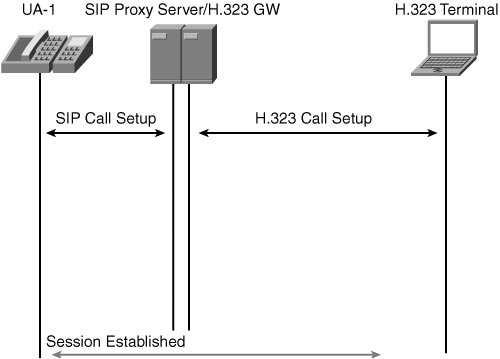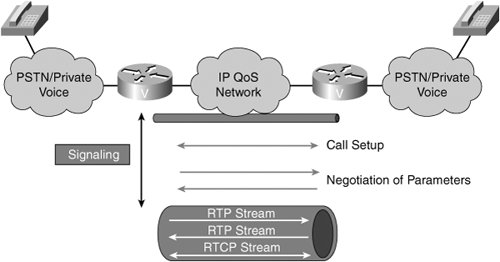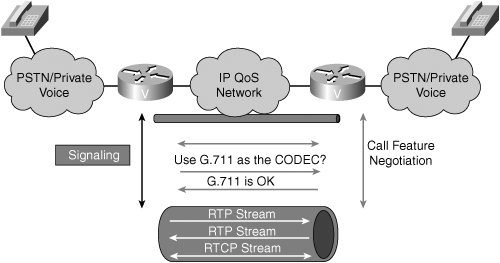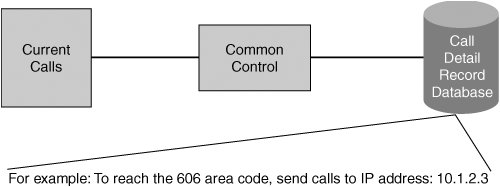The Need for Signaling and Call Control
| Signaling and call control are fundamental to the call establishment, management, and administration of voice communication in an IP network. This section discusses the benefits of using signaling and call control and offers an overview of what signaling and call control services provide. VoIP SignalingIn the traditional telephony network, a voice call consists of two paths:
ISDN D-channel signaling and Common Channel Signaling System 7 (CCSS7) or Signaling System 7 (SS7) are examples of signaling systems that are used in traditional telephony. By introducing VoIP into the call path, the end-to-end path involves at least one call leg that uses an IP internetwork. As in a traditional voice call, support for this VoIP call leg requires two paths:
A VoIP signaling and call control environment model includes endpoints and optional common control components, as described in the following sections. EndpointsEndpoints are typically simple, single-user devices, such as terminals, that support either a voice process (for example, the Cisco IP phone application) or a gateway. In either case, the endpoint must be able to participate in signaling with other VoIP endpoints, directly or indirectly, through common control components. The endpoints must also be able to manipulate the audio that is in the audio path. This might involve performing analog-to-digital conversion or converting the format to digital voice so that it takes advantage of compression technology. Gateways provide physical or logical interfaces to the traditional telephone network. A gateway that is connected digitally to a service provider central office (CO) switch is an example of a gateway providing a physical interface. A gateway providing access to an interactive response dialog application is an example of a gateway providing a logical interface. Common ControlIn some call control models, the common control component is not defined. In others, it is employed optionally. Common control components provide call administration and accounting. These components provide a variety of services to support call establishment, including the following:
Typically, the services of the common control components are implemented as applications. These services are collocated in a single physical device or distributed over several physical devices with stand-alone endpoints and gateways. Call Control ModelsCisco and other vendors support a variety of call control protocols. While this chapter focuses on H.323, SIP, and MGCP, some of the industry's most popular call control protocols include the following:
In the traditional telephone network, the individual call legs contributing to an end-to-end call often involve different signaling systems and procedures. The following section describes call control translation. Call Control TranslationIn Figure 6-1, an IP phone is communicating with its SIP proxy server using SIP. However, the IP phone is also attempting to reach an H.323 endpoint. Because the two VoIP protocols are different, a translation is necessary at the SIP proxy server (namely, an H.323 gateway) to allow the two telephony endpoints to establish a connection. Figure 6-1. Translation Between Signaling and Call Control Protocols A call between a residential user and an office worker likely involves a signaling system that is unique to the various call legs that exist between the originator and the destination. In this scenario, the sequence of signaling systems includes the following:
When part of the path is replaced with an IP internetwork, the audio path between the IP endpoints is provided by RTP, and the call control mechanism is based on a call control protocol, such as SIP, H.323, or MGCP. But what if different call control models represent the endpoints? What if, for example, the originating endpoint uses H.323 and the destination is managed as an SIP endpoint? To complete calls across the IP internetwork, a call control gateway that recognizes the procedures of both call control models is required. Specifically, the translating gateway interprets the call setup procedure on the originating side and translates the request to the setup procedure on the destination side. Ideally, this translation is transparent to the endpoints that are involved and results in a single endpoint-to-endpoint audio relationship. Call SetupAn audio path of a VoIP call leg is dependent on the creation of RTP sessions. These RTP sessions transport voice unidirectionally, so that bidirectional voice uses two RTP sessions. (In principle, if voice is needed in one direction only, as in the case of a recorded announcement or voice mail, only one RTP session is required.) Figure 6-2 shows RTP sessions being created during call setup. Figure 6-2. RTP Sessions To create RTP sessions, each endpoint must recognize the IP address and User Datagram Protocol (UDP) port number of its peer. In a limited implementation of VoIP, these values are preprogrammed. However, to be truly scalable, the addresses and port numbers must be recognized dynamically and on demand. Note During call setup, call control procedures exchange the IP address and UDP port numbers for the RTP sessions. Creating the RTP sessions is not the only task of call control during call setup. The endpoints need to establish a bilateral agreement in which the communicating parties discover acceptable call parameters and then agree on the operating parameters of the call, as depicted in Figure 6-3. Figure 6-3. Call Feature Negotiation When agreement is not possible, the call is not completed and is dropped. Following are some examples of call parameters:
Call Administration and AccountingCall administration and accounting functions provide optional services for the improved operation, administration, and maintenance of a VoIP environment. Accounting makes use of the historical information that is usually formatted as call detail records (CDRs). CDRs are useful for cost allocation and for determining call distribution and service grade for capacity planning purposes. Call administration includes the following capabilities:
The following sections describe each of these capabilities in more detail. Call Status and CDRsSeveral of the responsibilities assigned to call administration and accounting are dependent on access to current call status information or records of changes in the call status. Call status has both historical and instantaneous (real-time) benefits. Therefore, CDR functions include billing and capacity planning. Call status provides an instantaneous view of the calls that are in progress. This view assists other processes (for example, bandwidth management) and can assist an administrator with troubleshooting or help provide user support. CDRs, whose database is represented in Figure 6-4, include information about a call start time, duration, origin, destination, and other statistics that might be useful for a variety of purposes. This data is collected as a function of call status. Figure 6-4. Call Status Address ManagementWhen an endpoint registers with a call control component, it supplies its telephone address or addresses and, if it is a gateway, the addresses of the destinations it can reach. The endpoint provides other information relating to its capabilities. Multiple destinations that are reachable through a gateway are usually represented by a prefix. The use of a prefix allows call control to create a database that associates a telephony address, for example, with its corresponding IP address, as illustrated in Figure 6-5. Figure 6-5. Address Registration Note In the traditional telephony network, the address of a station is limited to the keys available on a dual-tone multifrequency (DTMF) keypad. In VoIP, an address takes on one of several other formats as well. For example, the address can be a host name or a URL. Figure 6-5 illustrates the Toronto gateway registering its accessibility information. In this example, the gateway informs the common control component that it can reach all telephone numbers in the 416 area. This information is deposited into a database for future reference. After an address is registered, it can be discovered through address resolution, as depicted in Figure 6-6. Figure 6-6. Address Resolution Address resolution translates a multimedia user address to an IP address so that the endpoints can communicate with each other to establish a control relationship and create an audio path. Admission ControlAdmission control has at least two aspects: authorization and bandwidth management. Access to a network should not imply permission to use the resources of the network. Common control limits access to the resources by checking the intentions and credentials of users before authorizing them to proceed. Also, because bandwidth is a finite resource, appropriate bandwidth management is essential to maintaining voice quality. Allowing too many simultaneous voice calls over an IP internetwork results in a loss of quality for both new and existing voice calls. To avoid degrading voice quality, a call control model establishes a bandwidth budget. By using data available from call status, the bandwidth management and Call Admission Control (CAC) functions monitor current bandwidth consumption. Calls might proceed up to the budgeted level, but are refused when the budget has reached its limit. This process is illustrated in Figure 6-7. Figure 6-7. Admission Control |
EAN: 2147483647
Pages: 111
- Key #3: Work Together for Maximum Gain
- Key #4: Base Decisions on Data and Facts
- Beyond the Basics: The Five Laws of Lean Six Sigma
- Making Improvements That Last: An Illustrated Guide to DMAIC and the Lean Six Sigma Toolkit
- The Experience of Making Improvements: What Its Like to Work on Lean Six Sigma Projects





